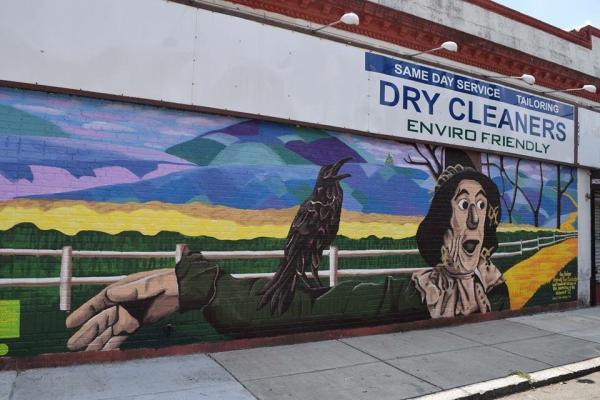August 3, 2016

The Mayor’s Mural Crew has completed work on large piece of art at the corner of St. Marks Road and Dorchester Avenue this summer that will serve as a tip-of-the-straw-hat to a Dorchester native who played a starring role in one of cinema’s most iconic works.
The mural depicts Ray Bolger, who portrayed the “Scarecrow” in the original 1939 film classic “Wizard of Oz.”
“I actually did not know the guy who played the scarecrow was from Boston,” said Timmy McGough, a rising senior at Boston Latin School. The Dorchester teen is one of several teens who are part of the mural crew, which was launched in 1991 for high school students who lived in the Codman Square area. Hundreds of city kids have since been a part of the effort.
“I think its great for young people to be doing art in the summer,” said Heidi Schork, who is the director of Mayor’s Mural Crew. The Boston youth work alongside with professional mural painters— like Schork— to paint large-scale murals throughout the city.
The mural crew works closely with organizations such as the Greater Ashmont Main Streets, which requested the Bolger mural, which took around two weeks to completed.
This is McGough’s first season on the mural crew, but at he takes art classes in school and will be in an AP art class for this upcoming school year.
The Mayor’s Mural Crew runs Monday through Friday from 8:30a.m. to 2p.m. The teens meet up each day at their designated site that they will be painting at. They paint every day, all day.
“It’s really fun to make art everyday,” said McGough.
From Codman Square and Dot High to Dancing with Judy in ‘Wizard of Oz’
A wondrous dancer and comedian in the early 20th century vaudeville era who earned immortal fame worldwide for his role as the brainless Scarecrow in the 1939 film “The Wizard of Oz,” Ray Bolger was a native of Codman Square and a graduate of the Oliver Wendell Holmes grammar school and Dorchester High, Class of 1920.
He took a tortuous route to his memorable portrayal of the dancer’s art in “Oz,” working odd jobs like most teens of his day, but finding opportunities to participate in Shakespearean productions along the way.
According to his obituary in the Boston Globe, after high school he worked for a peanut company, as a bank messenger, and for the New England Mutual Life Insurance Co. “I was a lonely kid. I didn’t know many people because I was always working,” he told the Globe.
With encouragement from local artists and promoters, he finally found his way to vaudeville by gaining a role on Broadway in “The Passing Show of 1926”; it was the beginning of almost 70 years of entertaining Americans on stage, in films, and at concerts and conventions for the elastic-legged dancer who could sing and act a bit, too.
-Tom Mulvoy
Topics:


